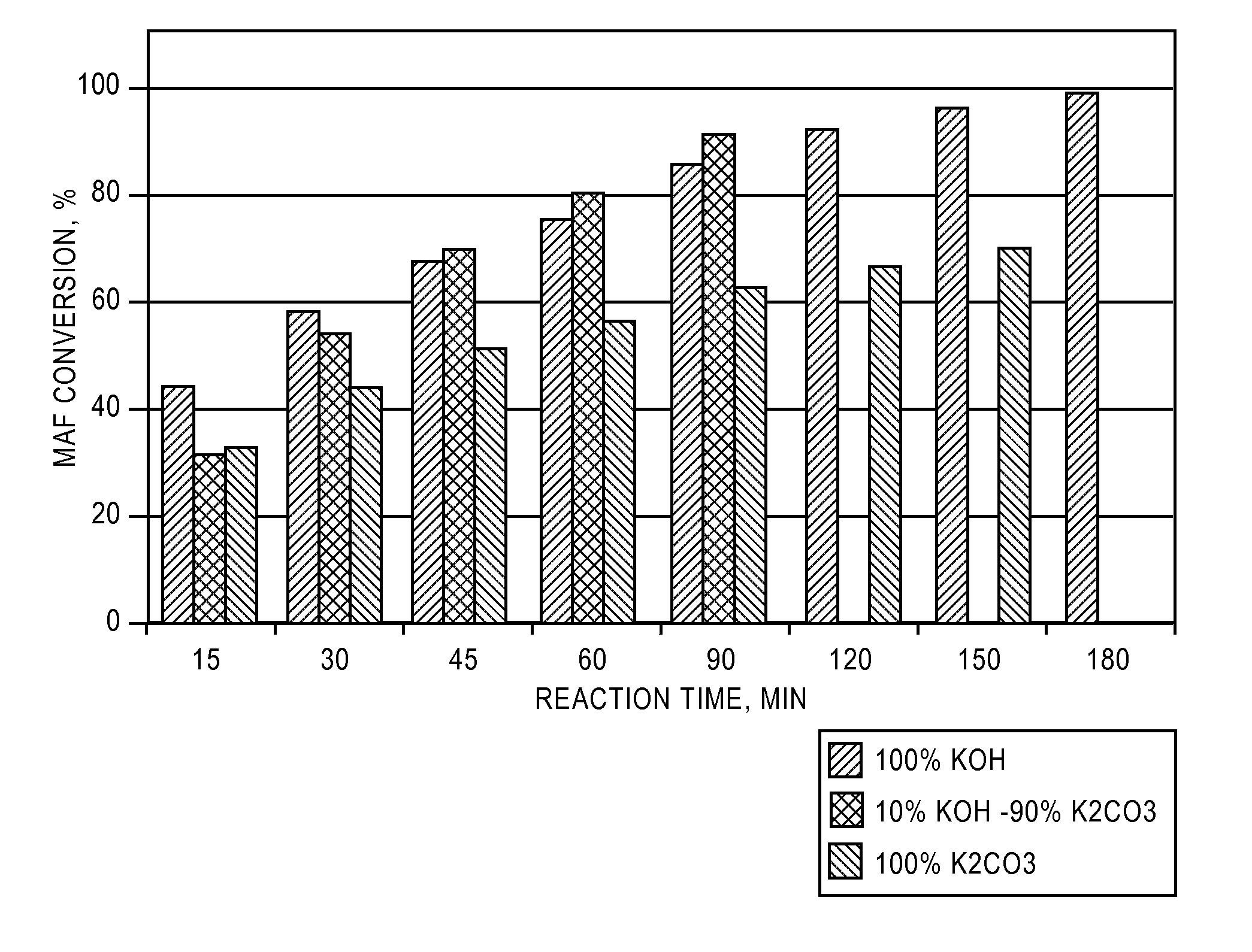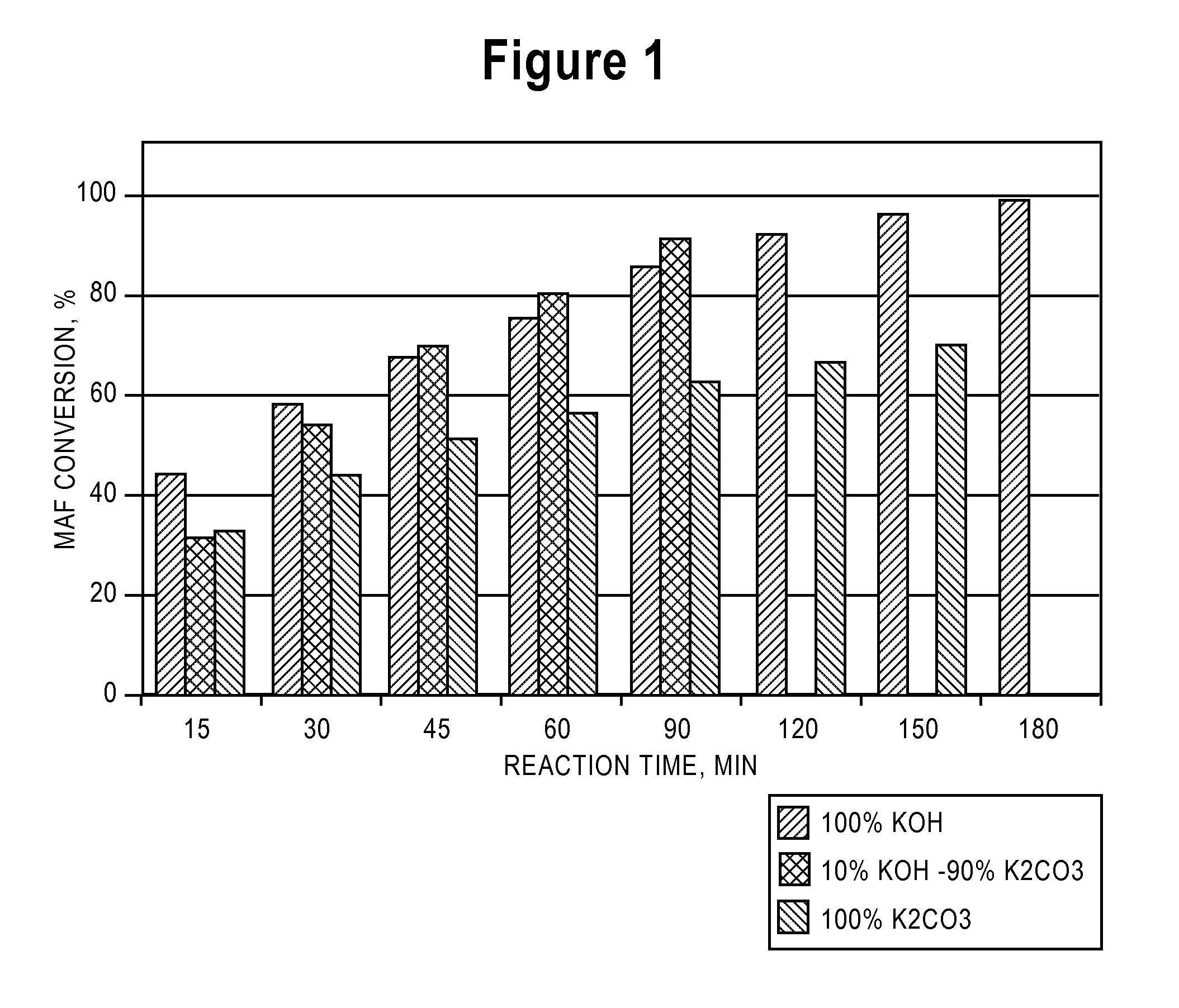Petroleum Coke Compositions for Catalytic Gasification
a technology of petroleum coke and compositions, which is applied in the field of petroleum coke compositions and alkali metal gasification catalysts, can solve the problems of poor gasification reactivity of petroleum coke in general, low water soaking capacity of conventional catalyst impregnation methods, and low water soaking capacity
- Summary
- Abstract
- Description
- Claims
- Application Information
AI Technical Summary
Benefits of technology
Problems solved by technology
Method used
Image
Examples
example 1
Petroleum Coke Sample Preparation
[0072]When the as-received petroleum coke is found to be too damp (i.e. not free-flowing) to be jaw-crushed, it is necessary to first air-dry it in a mechanical-convection oven at 35° C. for an extended period of time. Stage-crushing was performed carefully so as not to generate excessive fines and to maximize the amount of material having particle sizes below about 850 microns.
[0073]An analysis of a tar sands petroleum coke sample provided results as follows: 0.22 percent by weight moisture, 0.28 percent by weight ash (proximate analysis); carbon 88.81 percent, sulfur 5.89 percent and a btu / lb value of 15,210. The ash component of the petroleum coke contained 6.69 percent silica and 2.56 percent alumina, based on the weight of the ash.
[0074]Finely ground petroleum coke (with particle size between about 300 and 850 microns) was added to an Erlenmeyer flask, and a soaking solution of potassium hydroxide and potassium carbonate was added to the flask f...
example 2
Petroleum Coke Particulate Composition Gasification
[0075]Gasifications of the particulate composition from Example 1 were carried out in a high-pressure apparatus that included a quartz reactor. About a 100 mg of each sample was separately charged into a platinum cell held in the reactor and gasified. Typical gasification conditions were: total pressure, 500 psig; temperature, about 700° C.; and reaction times, up to 3 hr.; in an atmosphere of 66% H2O, 25.4% H2, and 8.6% CO.
example 3
Carbon Conversion for Samples of Coke Particulate
[0076]Three separate samples were prepared for gasification. In the first sample (PCC-007-S2B), the ground coke was soaked in a 15% potassium carbonate solution. In the second sample (PCC-039-S2I), the ground coke was soaked in a 15%-K2CO3-equivalent potassium hydroxide solution. In the third sample (PCC-043-S2L), the ground coke was soaked in a 15%-K2CO3-equivalent solution of potassium carbonate and potassium hydroxide (90% and 10%, respectively).
[0077]FIG. 1 shows the carbon conversion as a function of time for the three samples. Over the duration of the test, the sample treated with the soaking solution containing both potassium hydroxide and potassium carbonate showed the highest rate of carbon conversion. This sample had undergone full conversion 30-60 minutes before the other two samples. Because the three samples all had equivalent amounts of potassium, the amount of alkali metal present could not in and of itself account for ...
PUM
| Property | Measurement | Unit |
|---|---|---|
| particle size | aaaaa | aaaaa |
| particle size | aaaaa | aaaaa |
| particle size | aaaaa | aaaaa |
Abstract
Description
Claims
Application Information
 Login to View More
Login to View More - R&D
- Intellectual Property
- Life Sciences
- Materials
- Tech Scout
- Unparalleled Data Quality
- Higher Quality Content
- 60% Fewer Hallucinations
Browse by: Latest US Patents, China's latest patents, Technical Efficacy Thesaurus, Application Domain, Technology Topic, Popular Technical Reports.
© 2025 PatSnap. All rights reserved.Legal|Privacy policy|Modern Slavery Act Transparency Statement|Sitemap|About US| Contact US: help@patsnap.com


